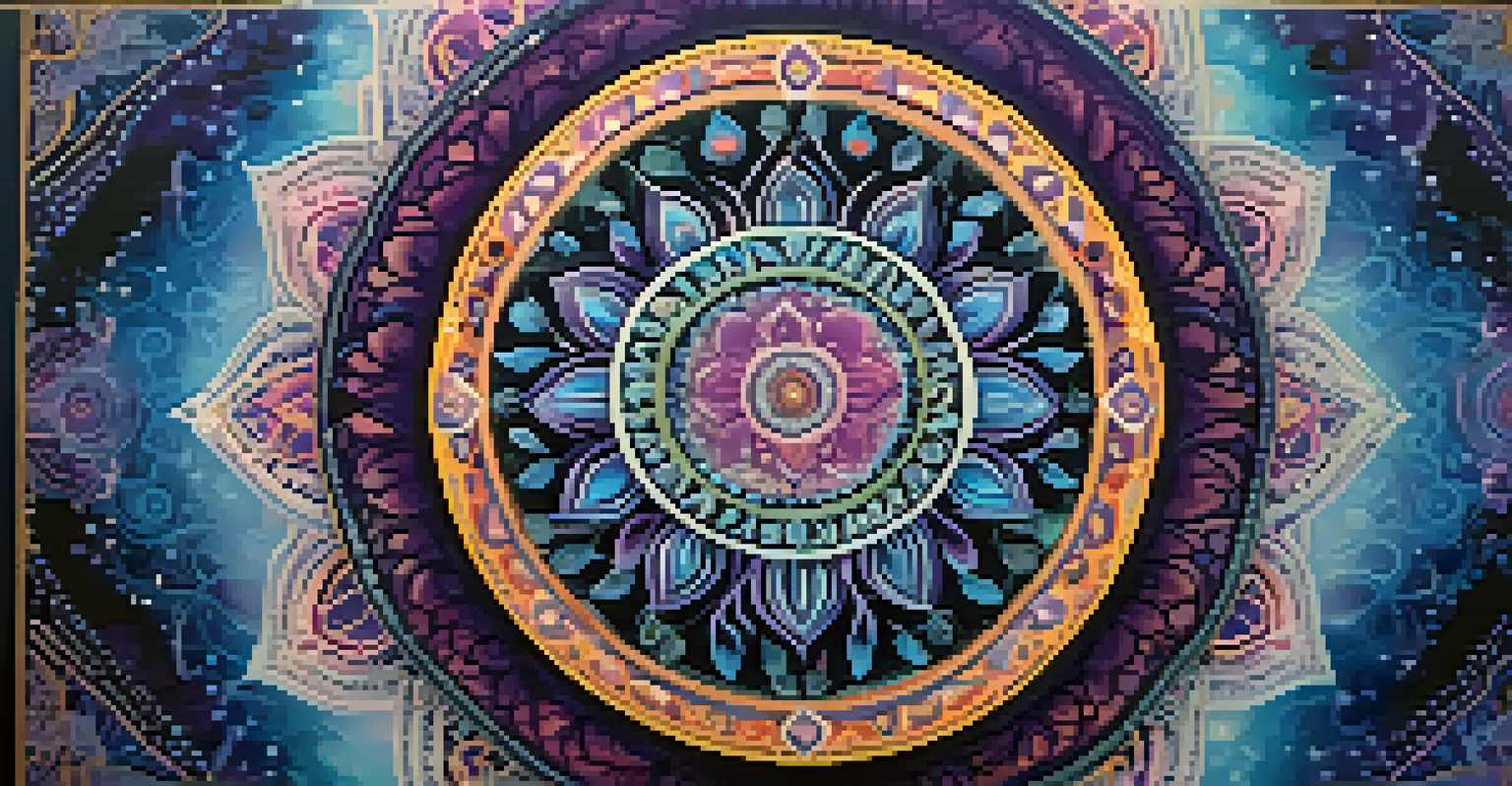The Influence of Buddhism on Eastern Painting Styles

Buddhism's Core Principles and Artistic Expression
At its heart, Buddhism emphasizes concepts like impermanence and mindfulness, which deeply influence artistic expression. This philosophy encourages artists to capture the transient beauty of life, leading to a focus on nature and spiritual themes in their work. The serene and often meditative qualities of Buddhist art invite viewers to reflect, offering a moment of peace amidst the chaos of everyday life.
Art is not a thing; it is a way.
For instance, many Eastern paintings depict serene landscapes and tranquil scenes that evoke a sense of harmony with the universe. Artists often use soft colors and fluid lines, which mirror the calmness that Buddhism promotes. This connection between art and spiritual philosophy not only enhances the aesthetic experience but also invites contemplation on deeper existential themes.
Moreover, the practice of mindfulness in Buddhism translates into a deliberate approach to art-making. Artists engage deeply with their materials and processes, often creating works that feel alive with intention. This infuses Eastern paintings with a sense of presence, making them more than mere decorations—they become windows into a spiritual journey.
The Role of Symbolism in Eastern Painting
Symbolism plays a crucial role in Eastern painting, particularly influenced by Buddhist beliefs. Common motifs such as lotus flowers, mountains, and mandalas carry profound meanings, representing enlightenment, stability, and the cosmos, respectively. These symbols allow artists to communicate complex ideas without relying solely on words, creating a visual language that resonates with viewers on multiple levels.

Take the lotus flower, for example. It emerges from muddy waters, symbolizing purity and spiritual awakening. In paintings, this imagery reflects the journey of the soul towards enlightenment, reminding viewers that beauty can arise from challenging circumstances. Such symbols create a layered experience that invites exploration and interpretation.
Buddhism Inspires Artistic Expression
Buddhism's core principles of impermanence and mindfulness profoundly influence artists to create works that capture the transient beauty of life.
Furthermore, the use of symbolism often reflects the interconnectedness of life, a core tenet of Buddhism. Artists incorporate elements that signify balance and harmony, reinforcing the idea that all beings are part of a larger whole. This perspective not only enriches the artwork but also encourages viewers to reflect on their own place within the universe.
Influence of Zen Buddhism on Minimalist Art
Zen Buddhism, a branch of Buddhism focusing on meditation and simplicity, has significantly shaped minimalist art in Eastern cultures. This style emphasizes the beauty of simplicity, often stripping away unnecessary elements to highlight the essence of a subject. In Zen-influenced paintings, the use of blank space is as important as the painted areas, symbolizing the concept of emptiness and potential.
The only lasting beauty is the beauty of the heart.
An example of this can be seen in traditional Sumi-e ink painting, where a single brushstroke can convey profound meaning. Artists trained in this practice learn to be present and intentional, allowing the brush to dance freely while remaining grounded in mindfulness. This approach results in works that feel spontaneous yet deeply considered, embodying the Zen principle of 'less is more.'
Moreover, Zen’s focus on nature further informs minimalist styles, as many paintings depict simple landscapes or solitary objects. This connection to the natural world emphasizes the tranquility and beauty found in simplicity, encouraging viewers to pause and appreciate the moment. By embracing minimalism, artists create a space for reflection, aligning with the meditative aspects of Zen Buddhism.
The Evolution of Buddhist Art Through History
Buddhist art has undergone significant transformation throughout history, reflecting the dynamic nature of cultural exchange and adaptation. Starting from its origins in India, art influenced by Buddhism spread to various regions, including China, Japan, and Southeast Asia, each adopting distinct styles and techniques. This evolution showcases the versatility of Buddhist themes and how they resonate across different cultures.
For example, the early Buddhist art of India featured intricate sculptures and wall paintings that depicted the life of the Buddha. As Buddhism traveled to China, it blended with local artistic traditions, leading to the development of styles like Chinese landscape painting, which often incorporated Buddhist philosophies. This fusion illustrates how Buddhism can adapt while still maintaining its core teachings.
Symbolism Deepens Artistic Meaning
Eastern paintings use rich symbolism, like the lotus flower, to convey complex spiritual ideas and invite viewers to engage in deeper contemplation.
In Japan, the arrival of Buddhism brought about new artistic practices such as the creation of elaborate temple decorations and ink paintings. Over time, these art forms evolved, influenced by Zen aesthetics and the samurai culture, creating a unique blend that continues to inspire artists today. This historical journey highlights the resilience of Buddhist art, continually evolving while remaining rooted in its spiritual origins.
Comparison of Buddhist and Non-Buddhist Eastern Art
While many Eastern art forms share common themes, Buddhist art distinctly emphasizes spirituality and meditation, setting it apart from non-Buddhist traditions. In contrast to secular art, which often focuses on beauty, social issues, or personal expression, Buddhist art serves a more profound purpose: to inspire contemplation and convey spiritual teachings. This focus shapes the choice of subjects, color palettes, and techniques used in creation.
For example, while a traditional Chinese landscape painting may celebrate nature's beauty, a Buddhist-inspired landscape often serves as a reminder of the impermanence of life and the interconnectedness of all things. The intention behind the artwork is what truly differentiates these styles, with Buddhist art aiming to elevate the viewer's consciousness rather than merely entertain.
Additionally, Buddhist art often employs a sense of minimalism and abstraction, contrasting with the ornate details found in many non-Buddhist Eastern art forms. This simplicity reflects the Buddhist ideals of non-attachment and mindfulness, inviting viewers to look beyond the surface and engage with deeper meanings. As a result, the experience of viewing Buddhist art can be both calming and enlightening, offering a unique perspective on the human experience.
The Impact of Modernity on Buddhist Art
As society evolves, so does art, and Buddhist art is no exception. In the modern era, artists are increasingly integrating contemporary themes and techniques into their work, reflecting the complexities of modern life while still drawing on traditional Buddhist principles. This blending of old and new creates a dynamic dialogue between past and present, making Buddhist art more accessible to contemporary audiences.
For instance, artists may use modern materials or digital media to reinterpret traditional Buddhist symbols and themes. This can result in vibrant, innovative works that resonate with younger generations while maintaining a connection to their spiritual roots. Such transformations highlight the adaptability of Buddhist art, ensuring its relevance in today's fast-paced world.
Modernity Shapes Buddhist Art's Future
Contemporary artists are blending traditional Buddhist themes with modern techniques, ensuring the art remains relevant and resonates with today's audiences.
Moreover, contemporary exhibitions often explore the intersection of Buddhism with global issues, such as environmentalism and social justice. By addressing these themes through a Buddhist lens, artists invite viewers to reflect on their roles as responsible global citizens. This evolution not only revitalizes Buddhist art but also reinforces its capacity to inspire and provoke thought in a rapidly changing world.
The Future of Buddhism in Eastern Painting
Looking ahead, the future of Buddhism in Eastern painting appears promising as artists continue to explore and reinterpret traditional themes. The ongoing dialogue between ancient practices and modern artistic expressions ensures that Buddhist art remains vibrant and relevant. As new generations of artists emerge, they bring fresh perspectives, infusing traditional concepts with contemporary ideas.
Furthermore, the global interest in mindfulness and spirituality creates a fertile ground for the growth of Buddhist art. As more people seek connections to their inner selves, the appeal of art rooted in Buddhist philosophy becomes increasingly significant. This trend may lead to the rise of innovative styles that resonate with both spiritual seekers and art enthusiasts alike.

Ultimately, the future of Buddhism in Eastern painting lies in its ability to adapt and inspire. By embracing change while honoring its rich heritage, Buddhist art can continue to foster a sense of peace and reflection in an ever-evolving world. As artists navigate this journey, they ensure that the teachings of Buddhism remain a vital part of the artistic landscape for years to come.